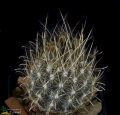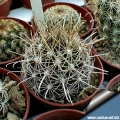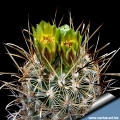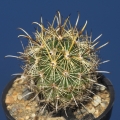




Your support is critical to our success.
Accepted Scientific Name: Sclerocactus scheeri (Salm-Dyck) N.P.Taylor
Bradleya 5: 94 (1987) basionym: Echinocactus scheeri
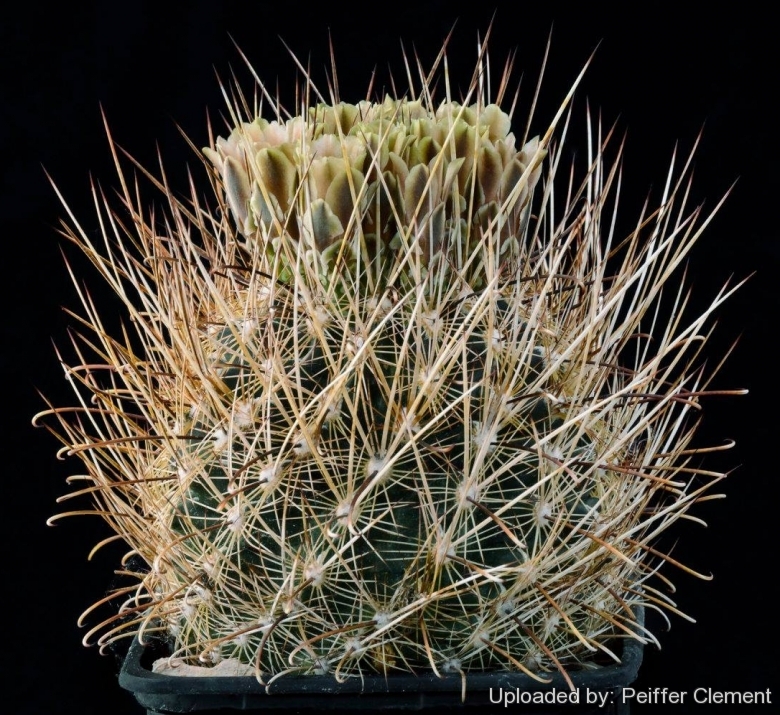
SB460 (Collector: Steven Brack) Monclova, Coahuila, Mexico
Origin and Habitat: USA (Texas); Mexico (Coahuila, Nuevo León, Tamaulipas).
Altitude: 20-1600 metres over sea level.
Habitat and Ecology: Sclerocactus scheeriSN|788]]SN|788]] grows under drip line of brush in Tamaulipan thorn scrub community, on grassy plains and open low hills or brushy areas in grasslands, on sandy, loamy, silty, or gravelly soils. It is scattered and not very abundant. There are no known major threats to this species. The same area support endemic succulents and xerophyte plants such as Mammillaria centraliferaSN|9350]]SN|11912]], Mammillaria plumosaSN|11912]]SN|9350]], Astrophytum asteriasSN|1464]]SN|1464]], Echinocereus blanckiiSN|7817]]SN|7478]], Echinocereus stramineusSN|7478]]SN|7817]], Thelocactus bicolorSN|15126]]SN|3420]], Thelocactus saussieriSN|3420]]SN|15126]], Echinocactus platyacanthus, Echinocactus horizonthalonius, Ferocactus stainesiiSN|13428]]SN|13428]], Agave striataSN|23013]]SN|562]], Coryphantha roederianaSN|10045]]SN|10045]], Opuntia bulbispinaSN|10979]]SN|9853]], Opuntia chollaSN|9853]]SN|10979]], Euphorbia antisyphilitica, Agave lechuguillaSN|562]]SN|23013]]... and many other.
Synonyms:
- Sclerocactus scheeri (Salm-Dyck) N.P.Taylor
- Ancistrocactus scheeri (Salm-Dyck) Britton & Rose
- Echinocactus scheeri Salm-Dyck
- Ferocactus scheeri (Salm-Dyck) N.P.Taylor
- Pediocactus scheeri (Salm-Dyck) Halda
Sclerocactus scheeri (Salm-Dyck) N.P.Taylor
Bradleya 5: 94 (1987)
Synonymy: 5
- Sclerocactus scheeri (Salm-Dyck) N.P.Taylor
- Ancistrocactus scheeri (Salm-Dyck) Britton & Rose
- Echinocactus scheeri Salm-Dyck
- Ferocactus scheeri (Salm-Dyck) N.P.Taylor
- Pediocactus scheeri (Salm-Dyck) Halda
Sclerocactus scheeri var. megarhizus (Rose) nov. comb. ined.
Synonymy: 4
- Sclerocactus scheeri var. megarhizus (Rose) nov. comb. ined.
- Ancistrocactus megarhizus (Rose) Britton & Rose
- Echinocactus megarrhizus Rose
- Ancistrocactus megarhizus f. gonzalesi n.n.
ENGLISH: Fishhook Cactus, Twisted Ribs Cactus, Scheer's Fish-hook Cactus, Tobusch Fishhook Cactus, Root cactus
SPANISH (Español): Biznaga-bola Ganchuda
Description: Sclerocactus scheeriSN|788]]SN|788]] best known as Ancistrocactus scheeriSN|3503]]SN|787]] is a small fish-hook cactus with a large fleshy turnip root, neck-shaped grown together with the stem. The spines varies from yellow to brown and often prevent the flowers from opening fully. Flowering in early spring; flowers pale-green or yellow-green.
Habit: Solitary (unless injured) until very old age, or with few branches from ground level when old. Seedlings and immature plants often have narrowly cylindrical stems. With age, the stems broaden distally.
Stem: Cylindrical to club-shaped, or spheric, up to 17cm tall, 5-8 cm in diameter.
Spines: Radial spines 13-28 per areole, translucent yellowish, tips red-brown, longest spines 6 to 28 mm long; central spines 3-4 per areole; abaxial central spine tan to whitish 1 per areole, hooked terete or slightly flattened, generally whitish or light brown, 12-38 mm long; adaxial central spines (2-)3 per areole, brown to dark reddish brown, erect, straight, 19-50 mm long. Juvenile spines are all radials numerous, short, tightly appressed and pectinate.
Roots: Long, fleshy, tuberlike taproots, sometimes having bulbous secondary roots horizontally oriented, sausage-shaped or otherwise strongly tuberlike, but always separated from the stem by a fragile constriction, in contrast to the short, succulent, vertical taproots of Ancistrocactus brevihamatus.
Flowers: Bright green to yellowish (rarely pink to pale reddish) with a brown midline. Flowering in February-March.
Remarks: Ancistrocactus scheeriSN|787]]SN|787]] is relatively similar above ground to the related species Ancistrocactus brevihamatusSN|3503]]SN|3503]], but the roots of Ancistrocactus scheeriSN|3503]]SN|787]] are frequently horizontally oriented, strongly tuberlike and always separated from the stem by a fragile constriction, in contrast to the short, succulent, vertical taproots of Ancistrocactus brevihamatusSN|787]]SN|3503]]; and also the stems of immature Ancistrocactus brevihamatusSN|3503]]SN|3503]], are not obscured by spines and are often flush with the soil surface, whereas those of Ancistrocactus scheeriSN|787]]SN|787]] are nearly hidden by spines and fully exposed above the soil.
Ribs on the stems of Ancistrocactus scheeri seem straighter and better defined than ribs of Ancistrocactus brevihamatusSN|787]]SN|3503]], even prior to sexual maturity.
Subspecies, varieties, forms and cultivars of plants belonging to the Sclerocactus scheeri group
 Ancistrocactus megarhizus f. gonzalesi n.n.: is a local or morphological form not easily differentiated from the standard Sclerocactus scheeri var. megarhizus. Distribution: Gonzales, Tamaulipas, Mexico.
Ancistrocactus megarhizus f. gonzalesi n.n.: is a local or morphological form not easily differentiated from the standard Sclerocactus scheeri var. megarhizus. Distribution: Gonzales, Tamaulipas, Mexico. Sclerocactus scheeri (Salm-Dyck) N.P.Taylor: Solitary cactus with a cylindric to club-shaped stem. Radial spines 13-28 per areole; central spines 3-4 per areole; one of which hooked. Roots frequently horizontally oriented, strongly tuberlike and always separated from the stem by a fragile constriction.
Sclerocactus scheeri (Salm-Dyck) N.P.Taylor: Solitary cactus with a cylindric to club-shaped stem. Radial spines 13-28 per areole; central spines 3-4 per areole; one of which hooked. Roots frequently horizontally oriented, strongly tuberlike and always separated from the stem by a fragile constriction. Sclerocactus scheeri var. megarhizus (Rose) nov. comb. ined.: The peculiar characteristic of this species are the long, fleshy, tuber-like taproots.
Sclerocactus scheeri var. megarhizus (Rose) nov. comb. ined.: The peculiar characteristic of this species are the long, fleshy, tuber-like taproots.
Bibliography: Major references and further lectures
1) Edward Anderson “The Cactus family” Timber Press, Incorporated, 2001
2) Nathaniel Lord Britton, Joseph Nelson Rose “Cactaceae: Descriptions and Illustrations of Plants of the Cactus Family” vol. 4 The Carnegie Institution of Washington, Washington 1923
3) James Cullen, Sabina G. Knees, H. Suzanne Cubey "The European Garden Flora Flowering Plants: A Manual for the Identification of Plants Cultivated in Europe, Both Out-of-Doors and Under Glass" Cambridge University Press, 11/Aug/2011
4) David R Hunt; Nigel P Taylor; Graham Charles; International Cactaceae Systematics Group. "The New Cactus Lexicon" dh books, 2006
5) Heil, K. & Terry, M. 2013. Sclerocactus scheeri. In: IUCN 2013. "IUCN Red List of Threatened Species." Version 2013.2.
6) Ancistrocactus scheeri <http://www.efloras.org>. Downloaded on 08 March 2014.
7) Flora of North America Editorial Committee "Flora of North America: North of Mexico. Magnoliophyta: Caryophyllidae" Oxford University Press, 1993
8) Brian Loflin, Shirley Loflin "Texas Cacti: A Field Guide" Texas A&M University Press, 26/ott/2009
9) Alfred Richardson "Plants of Deep South Texas: A Field Guide to the Woody and Flowering Species" Texas A&M University Press, 2010
10) Del Weniger "Cacti of the Southwest: Texas, New Mexico, Oklahoma, Arkansas, and Louisiana" University of Texas Press, 1969
11) J. H. Everitt, Dale Lynn Drawe, Robert I. Lonard "Trees, Shrubs, and Cacti of South Texas" Texas Tech University Press, 2002
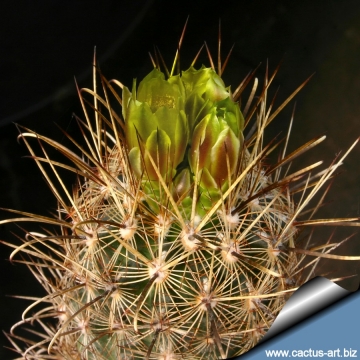
Ferocactus scheeri (Sclerocactus scheeri) Photo by: Cactus Art
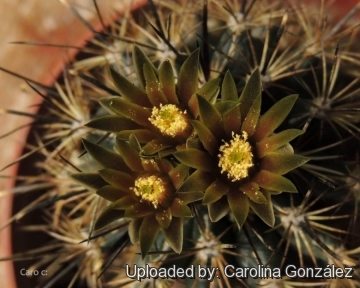
Ferocactus scheeri (Sclerocactus scheeri) Photo by: Carolina González
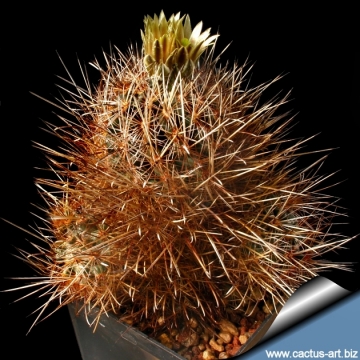
Ferocactus scheeri (Sclerocactus scheeri) Photo by: Cactus Art
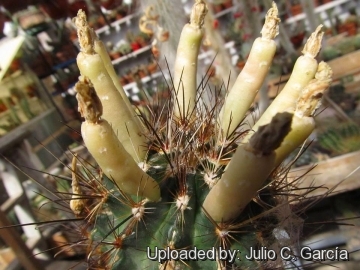
Ferocactus scheeri (Sclerocactus scheeri) Photo by: Julio C. García
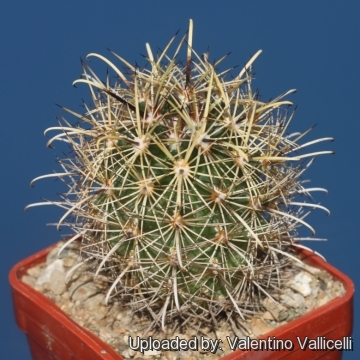
SB263 ( Collector: Steven Brack) Locality: Saltillo, Coahuila, Mexico (Sclerocactus scheeri) Photo by: Valentino Vallicelli
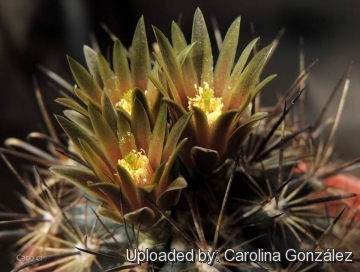
Ferocactus scheeri (Sclerocactus scheeri) Photo by: Carolina González
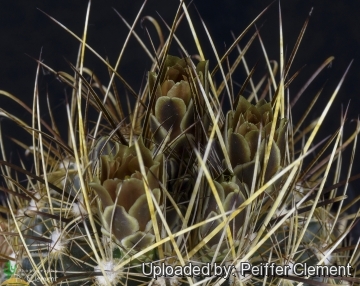
Ferocactus scheeri (Sclerocactus scheeri) Photo by: Peiffer Clement
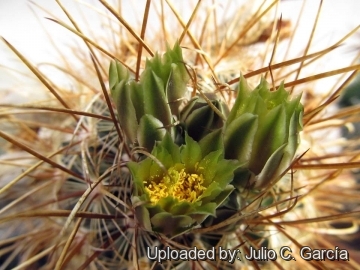
The natural hooked spine, was used by Indians to catch tiny fish. (Sclerocactus scheeri) Photo by: Julio C. García
Cultivation and Propagation: This plant is relatively rare in cultivation and has the fame to be difficult to grow on its own roots because it is very sensitive to overwatering (rot prone) and slow-growing. This species is extremely xerophytic, cold hardy and adapted to very dry soils, but plants grafted on an hardy stock are easy to grow and no special skill is required.
Soil: Grow it in an open mineral, sandy-gritty cactus compost.
Pots: It needs a relatively large or deep pot to accommodate its extensive roots and provide a very good drainage. They may stay in the same pot for many years.
Watering: Water it sparingly and keep it completely dry during winter or when night temperatures remain below 10° C. Mature individuals easily rot and die especially after planting so be extremely cautious with watering. Water it less than average if in bigger pots.
Special need: Provide very good ventilation. Nearly all problems occur as a result of overwatering and poor ventilation, especially when weather conditions are dull and cool or very humid. They must have very dry atmosphere.
Fertilization: Feed them once during the growing season with a fertilizer specifically formulated for cactus and succulents (high potash fertilizer with a dilute low nitrogen), including all micro nutrients and trace elements diluted to ½ the strength recommended on the label. They thrive in poor soils and need a limited supplies of fertilizer to avoid the plants developing excess vegetation, which is easily attacked by fungal diseases.
Exposure: It will do its best with lots of sun and become stressed with inadequate light which could result in poor growth and unnatural shape.
Hardiness: An unheated greenhouse would be perfect. It can survive low temperatures, approx. -7° (-12°) C.
Use: This is a good pot plant suited for a non heated green house. It can be also cultivated outdoors in raised beds, terraces if sheltered from winter rain. This cactus continues to be, a particular prize among collectors.
Pests & diseases: These cacti may be attractive to a variety of insects, but plants in good condition should be nearly pest-free, particularly if they are grown in a mineral potting-mix, with good exposure and ventilation. Nonetheless, there are several pests to watch for:
- Red spiders: Red spiders may be effectively rubbed up by misting the plants from above.
- Mealy bugs: Mealy bugs occasionally develop aerial into the new leaves and flowers with disfiguring results, but the worst types develop underground on the roots and are invisible except by their effects.
- Scales, thrips and aphids: (they are rarely a problem.)
- Rot: Rot is only a minor problem if the plants are watered and “aired” correctly. If they are not, fungicides won't help all that much.
Propagation: Seeds are quite difficult to germinate and a low rate of success, seedling did not do well either, and some die each year. The seeds can be sown in pots of fine, well-drained sandy soil, any time during the spring when temperatures are warm. Cover the seeds with a fine layer of grit and water from below with a fungicide to prevent damping off. For the 1-2 weeks cover the pots with a sheet of glass/clear perspex to keep the humidity levels high. Remove the glass and replace it with light shade-cloth and mist once or twice a day for the next two weeks after which most seeds should have germinated. From then on mistings can be reduced to every second and then every third day as the little plants grow. Grafting is often used to speed growth rate and to create a back-up for plants in collection.
| Your Actions | |
|---|---|
| Back to Ferocactus index | |
| Back to Cactaceae index | |
 |
Back to Cacti Encyclopedia index |
Privacy stantement - Terms and conditions - How to cite - About us - Feedback - Donate





